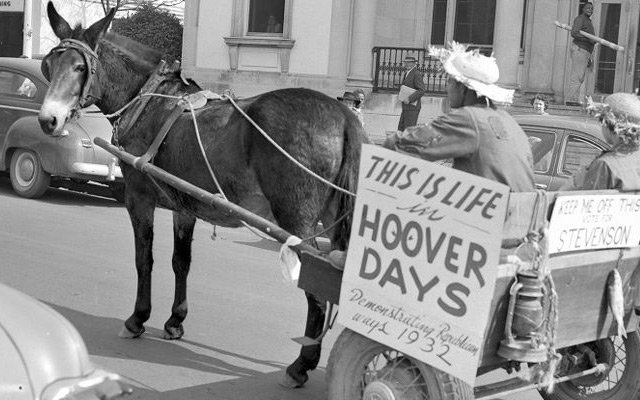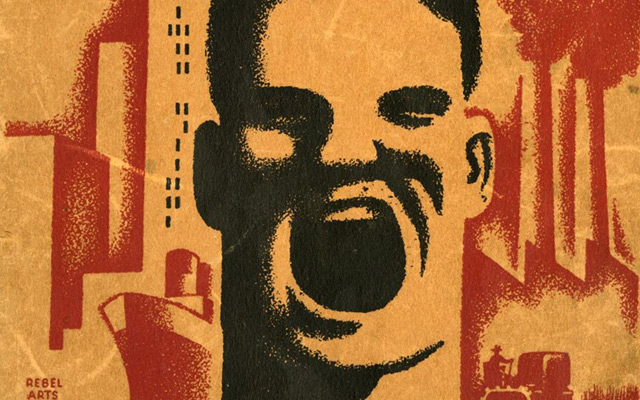Hoover cart at election day demonstration
- Title
- Hoover cart at election day demonstration
- Description
- Two people in a mule-drawn Hoover cart reminding voters of Herbert Hoover's administration and urging them to vote for Adlai Stevenson in the 1952 Presidential election. The sign attached to the side of the cart reads "This is life in Hoover Days, Demonstrating Republican Ways 1932". The Hoover cart was driven by North Carolina farmers as a form of transportation during the Depression and was built by taking the rear wheels off of a car and attaching them to a cart. The cart was then pulled by either mule or horse. The drivers of these carts would stop at service stations for water for the horse or mule and air for the tires, for which there was no cost. Date from negative sleeve.
- Date
- 1951
- Original Format
- negatives
- Extent
- 12cm x 10cm
- Local Identifier
- 0741-b1-fd-v1.d.57
- Contributor(s)
- Subject(s)
- Democratic Party (N.C.)
- Horse-drawn omnibuses--North Carolina--Greenville
- Political posters, American--North Carolina--Greenville
- Presidents--United States--Election--1952
- Spatial
- Location of Original
- East Carolina Manuscript Collection
- Rights
-
Copyright held by East Carolina University. Permission to reuse this work is granted for all non-commercial purposes.
http://rightsstatements.org/vocab/InC-NC/1.0/ - Permalink
- https://digital.lib.ecu.edu/2014
- Preferred Citation
- Cite this item
- This item
-
 Hoover cart at election day demonstration
Hoover cart at election day demonstration
- My Collections Login
- Printable Feedback Form
- is part of
-
 Sleeve 57, Folder d, Box 1
Sleeve 57, Folder d, Box 1
- Found in theme/project
-
 Politics and Government
Politics and Government
-
 Daily Reflector Images
Daily Reflector Images
-
 Politics and Government: North Carolina
Politics and Government: North Carolina
-
 Special Collections Staff Picks
Special Collections Staff Picks
-
 Transportation
Transportation
- Location of Original
- Daily Reflector Negative Collection from the East Carolina Manuscript Collection
- View all digitized items from the Daily Reflector Negative Collection
Related Search Results
Public access is provided to these resources to preserve the historical record. The content represents the opinions and actions of their creators and the culture in which they were produced. Therefore, some materials may contain language and imagery that is outdated, offensive and/or harmful. The content does not reflect the opinions, values, or beliefs of ECU Libraries.
Contact Digital Collections
If you know something about this item or would like to request additional information, click here.
Comments
In the picture shown of the Hoover Cart it is using the front axle of a car or truck with the tie rod showing at the rear (small rod between the wheels attached to the steering arms) and not the rear axle assembly as the center section (Hog Head as it was called) would be shown in the middle of the axle. where the drive shaft would attach.Some carts used the leaf springs from the cars/trucks but most were mounted solid like in the picture.
Many thanks for the Hoover Cart picture. For forty years I traveled the SW states selling furniture for NC factories; when the subject of the Depression came up, I would make mention of Hoover Carts, and no one had ever heard of them. I do believe they were indigenous to Eastern North Carolina.
To make a Hoover Cart you cut the car in half, take the back half, rig shafts to it so that a mule can be hitched. The flat tires are stuffed with rope and off you go to town. The Hoover Cart was indigenous to Edgecombe and its surrounding counties during the 1930s.
The building in the background was the Post Office. This is on Evans Street. The Pitt County Courthouse would be behind the photographer
Comment on This Item
Complete the fields below to post a public comment about the material featured on this page. The email address you submit will not be displayed and would only be used to contact you with additional comments or questions.



My mother in law talked about riding in a Hoover cart. She was born in 1920 and lived in Jason, NC. I think that’s Green or Lenior county,